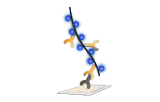The Polymer Detection method for Immunohistochemistry (IHC) is an innovative and highly sensitive technique widely used in biomedical research and clinical diagnostics to detect specific antigens in tissue samples. This method enhances traditional IHC staining by utilizing a polymer backbone conjugated with multiple enzyme molecules, allowing for superior signal amplification. As a result, it provides clearer, more intense staining with reduced background noise, making it an ideal choice for detecting low-abundance proteins and subtle biological changes in tissue morphology.
What is Polymer Detection in IHC?
Polymer detection systems use secondary antibodies attached to a polymer chain that carries a high density of enzyme molecules such as horseradish peroxidase (HRP) or alkaline phosphatase (AP). This design significantly amplifies the immunohistochemical signal because many enzyme molecules accumulate at the site of the antigen-antibody binding, producing a robust and easily visualized colorimetric reaction. Unlike conventional avidin-biotin complex (ABC) or streptavidin-biotin systems, polymer detection eliminates issues of endogenous biotin interference, ensuring cleaner and more specific staining results.
Advantages of Polymer Detection Systems
-
Increased Sensitivity: The polymer backbone loaded with multiple enzyme molecules allows for stronger signal generation, facilitating the detection of proteins expressed in very low quantities.
-
Improved Specificity: Reduced background staining minimizes nonspecific binding, which can obscure results in other detection methods.
-
Simplified Protocol: Polymer detection often requires fewer incubation steps compared to traditional methods, reducing hands-on time and potential errors.
-
Compatibility: It is well-suited for use with formalin-fixed paraffin-embedded (FFPE) tissues and various antigen retrieval techniques, making it versatile across many research and diagnostic applications.
-
Multiplexing Capabilities: Some polymer detection systems enable multiplex IHC, allowing simultaneous visualization of multiple targets in one tissue section.
Why Choose Polymer-Based Detection for Your IHC Needs?
Researchers and clinicians often prefer polymer detection methods because they combine sensitivity, specificity, and ease of use. These systems are especially valuable when analyzing precious or limited tissue samples, such as biopsies, where maximizing signal clarity is crucial. Polymer detection also supports consistent and reproducible results, a critical factor in both research publications and diagnostic decision-making.
By integrating the polymer detection method in your IHC workflow, you can achieve sharper, more reliable staining outcomes that advance both basic research and clinical pathology insights.
This thorough approach to polymer detection in IHC improves immunohistochemical analysis, ensuring vivid and trustworthy visualization of target proteins, which helps drive discoveries in fields such as cancer research, neuroscience, and infectious disease pathology.



